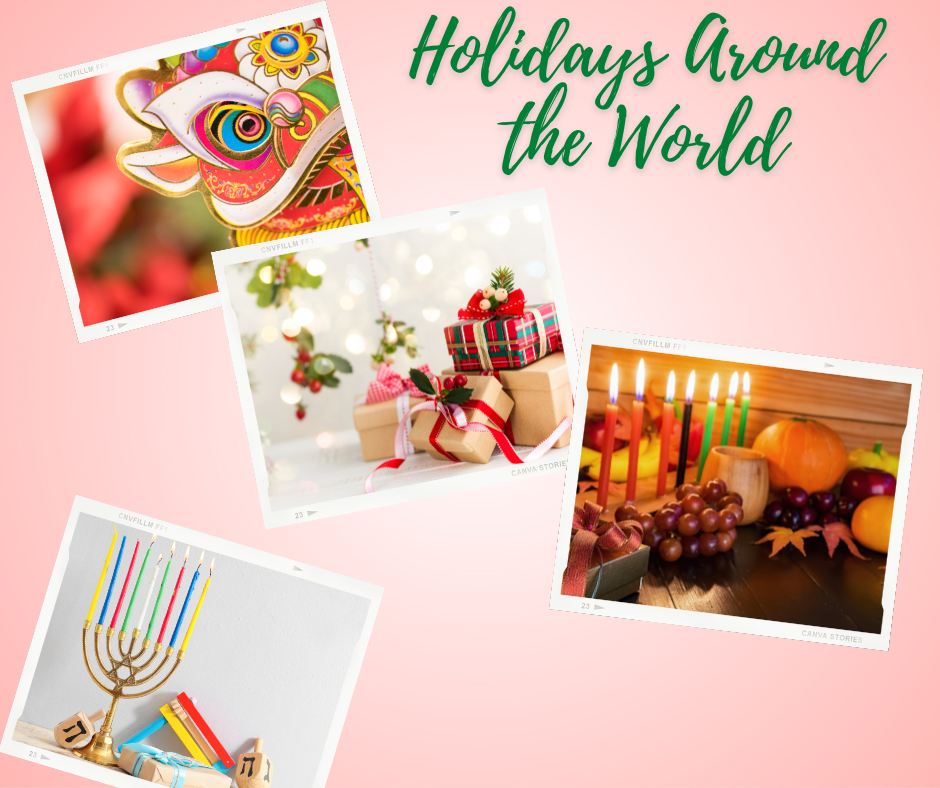Following-up from where we left off in the last article. We spoke about some holiday celebrations and lessons that can be learnt from them. Specifically, we dived into the Chinese New Year. Part 2 of this blog will continue to highlight lessons that can be passed on to future generations, through learning about the additional holidays mentioned prior (Hanukah, Christmas and Kwanza).
Hanukah
Hanukah, also known as the Festival of Lights, is celebrated some time between late November to late December. This celebration lasts for 8 days. A menorah (meh-nor-ah), which is a special candle holder, holds 9 candles. The ninth candle which is called a shamash, is used to light the other eight candles, one for each night of Hanukah. As a part of the celebration, people sing songs and family and friends eat together. A special top, called a dreidel, is used in games. Traditionally, people give gifts as well as money. Children are typically encouraged to share some of the money they receive with others who are less fortunate.
Hanukah: the take-away
- Family and friends are important. Again, we all need someone in our lives. Someone to love us and for us to love.
- It is nice to receive, but it’s also important to give. Additionally, we should look out for those who need help. Hence young children are motivated to share a little of the money they receive with others.
- In all things, remember to have fun. Thus the dreidel. Laugher uses far less facial muscles than frowning and releases those feel good hormones that we so need in order to feel less stressed.
Christmas
While Christmas is celebrated on the 25th of December each year, celebration and events usually start weeks in advance and last into the beginning of the new year. Christmas colors are red, green and white and can be seen throughout the various decorations and food. Gifts are usually wrapped and placed underneath a Christmas tree. Clothing, toys and food are collected and donated to the less fortunate. Visiting with family and friends, eating together and opening gifts, singing songs and sharing family stories (reminiscing) are the norms. Many Christians also attend church to sing and praise together. Some places have Christmas parades and other celebratory activities. Some families, spend hours decorating the interior and exterior of the homes in Christmas lights and holiday themes.
Christmas: the take-away
- Family and friends are a focal point. Does this sound familiar? Is is a recurring theme? Yes it is!
- Bright colors are used to liven-up the celebration and enhance the joy and happiness all around. Bright colors bring about cheerfulness, high spirits and a sense of purpose and expectations.
- A sense of human decency and love is shown through thoughts and actions towards persons who have less to survive on. This is also a recurring theme throughout these global celebrations. An emphasis on helping those who are struggling or in need.
- A belief in a higher being, who is capable to do and provide what people can’t do for themselves.
Around the globe, near and far, holiday celebrations are a wonderful way to see and view the world and the good in it.
Join us for the 3rd and final installment of this article. We welcome any positive experience you may have encountered through holiday celebrations.
Missed Part 1? No need to worry. Follow this link and happy travels Holidays Around the World: What Can They Teach Us (Part 1)
